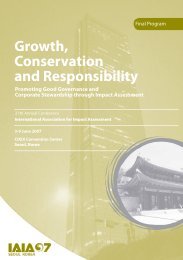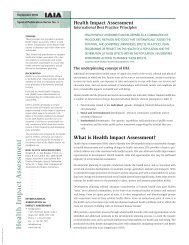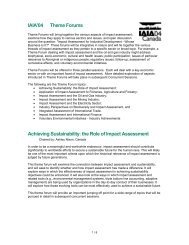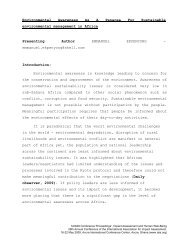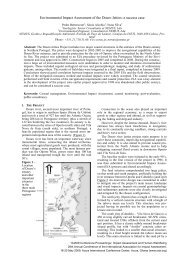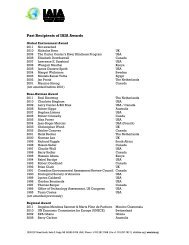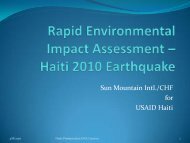Environmental impact assessment in Nigeria - International ...
Environmental impact assessment in Nigeria - International ...
Environmental impact assessment in Nigeria - International ...
You also want an ePaper? Increase the reach of your titles
YUMPU automatically turns print PDFs into web optimized ePapers that Google loves.
The m<strong>in</strong>imum requirement of an EIA report <strong>in</strong>cludes not only the<br />
description of the activity, potential affected environment, practical<br />
alternative, and <strong>assessment</strong> of likely or potential environmental <strong>impact</strong>s, but<br />
also identification and description of the mitigation measures, <strong>in</strong>dication of<br />
gaps <strong>in</strong> knowledge, notification of trans-state adverse environmental effects<br />
(if any) and a brief non-technical summary of all the above <strong>in</strong>formation.<br />
Impartial and written FEPA decisions <strong>in</strong>dicat<strong>in</strong>g mitigation measures based<br />
on a detailed exam<strong>in</strong>ation of environmental effects identified <strong>in</strong> the<br />
environmental <strong>impact</strong> <strong>assessment</strong> (after an opportunity with<strong>in</strong> an<br />
appropriate period had been given to the stakeholders and the public for<br />
their comments) is made available to <strong>in</strong>terested person(s) or group(s). It<br />
provides, where necessary, that potentially affected States or Local<br />
Government Areas are notified.<br />
PROCESS AND PROCEDURAL FRAMEWORK<br />
The EIA process is the various stages a project undergoes from proposal to<br />
approval for implementation, result<strong>in</strong>g <strong>in</strong> the issu<strong>in</strong>g of an <strong>Environmental</strong><br />
Impact Statement (EIS) and certificate.<br />
The term encompasses several stages, viz:<br />
• determ<strong>in</strong><strong>in</strong>g if FEPA environmental laws/regulations have been<br />
triggered;<br />
• screen<strong>in</strong>g a project for potential environmental effects;<br />
• scop<strong>in</strong>g to determ<strong>in</strong>e the spatial and temporary dimension of<br />
environmental effects;<br />
• carry<strong>in</strong>g out detailed base l<strong>in</strong>e studies to determ<strong>in</strong>e the environmental<br />
condition prior to project implementation;<br />
• prepar<strong>in</strong>g a detailed <strong>assessment</strong> report;<br />
• carry<strong>in</strong>g out a panel review of the EIA report if this is necessary; and<br />
• obta<strong>in</strong><strong>in</strong>g authorization/approval, where appropriate.<br />
For FEPA, the Director General/Chief Executive is the responsible officer.<br />
The National Procedural Guidel<strong>in</strong>es show practical steps from project<br />
conception to commission<strong>in</strong>g (see Figure 2). The steps are:<br />
• project proposal<br />
• <strong>in</strong>itial environmental exam<strong>in</strong>ation (IEE)/prelim<strong>in</strong>ary <strong>assessment</strong><br />
• screen<strong>in</strong>g<br />
• scop<strong>in</strong>g<br />
• EIA study<br />
• review<br />
• decision mak<strong>in</strong>g<br />
• monitor<strong>in</strong>g, and<br />
68<br />
UNEP EIA Tra<strong>in</strong><strong>in</strong>g Resource Manual ® Case studies from develop<strong>in</strong>g countries


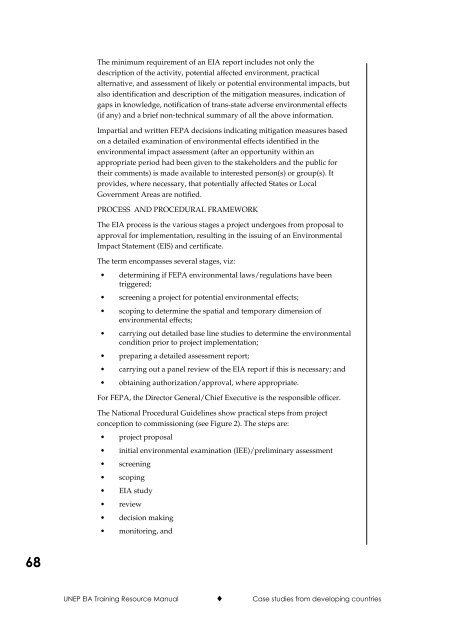

![Session Report [PDF] - International Association for Impact Assessment](https://img.yumpu.com/22416146/1/190x245/session-report-pdf-international-association-for-impact-assessment.jpg?quality=85)
![Session Report [PDF] - International Association for Impact Assessment](https://img.yumpu.com/22416140/1/184x260/session-report-pdf-international-association-for-impact-assessment.jpg?quality=85)
